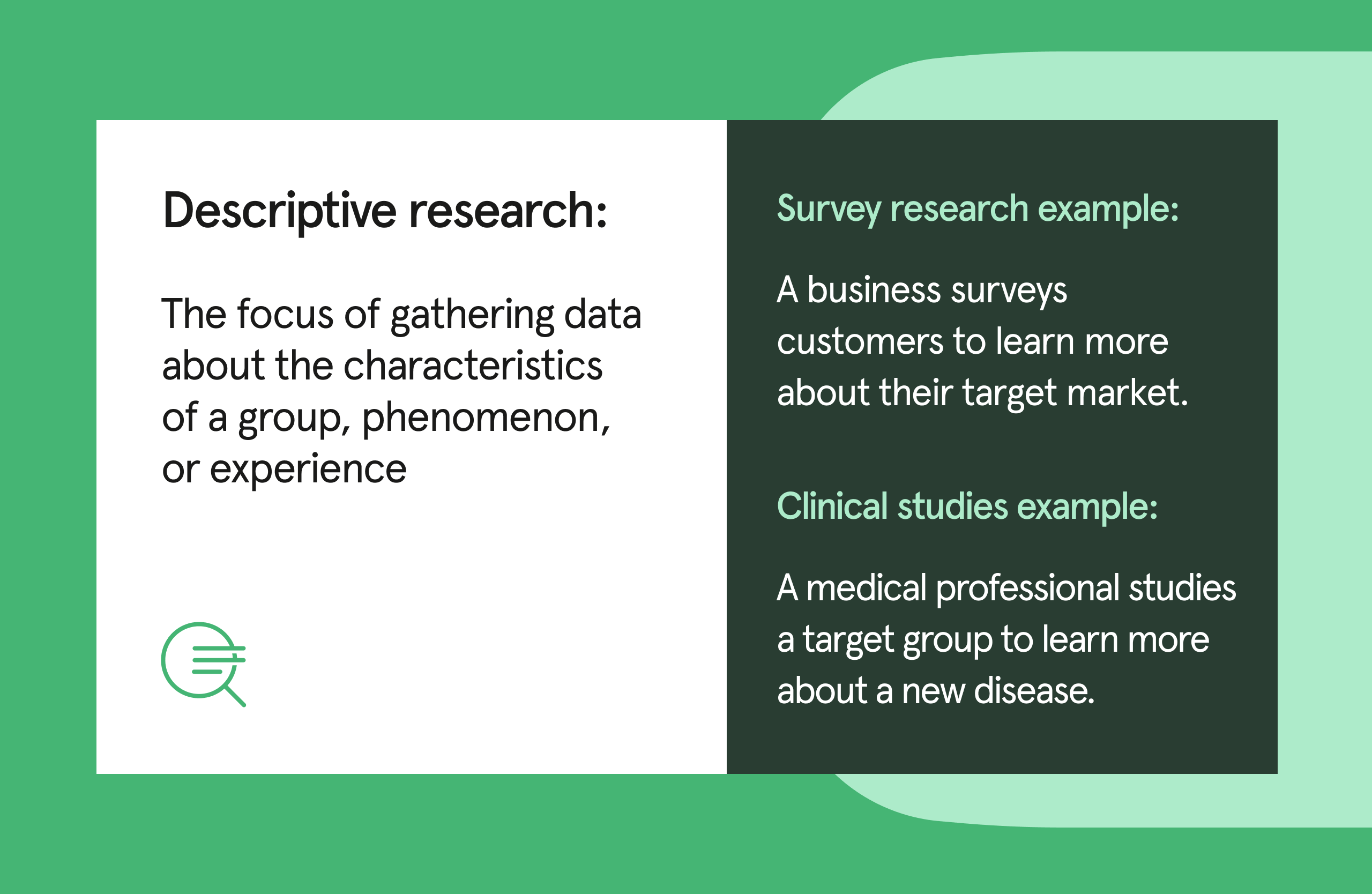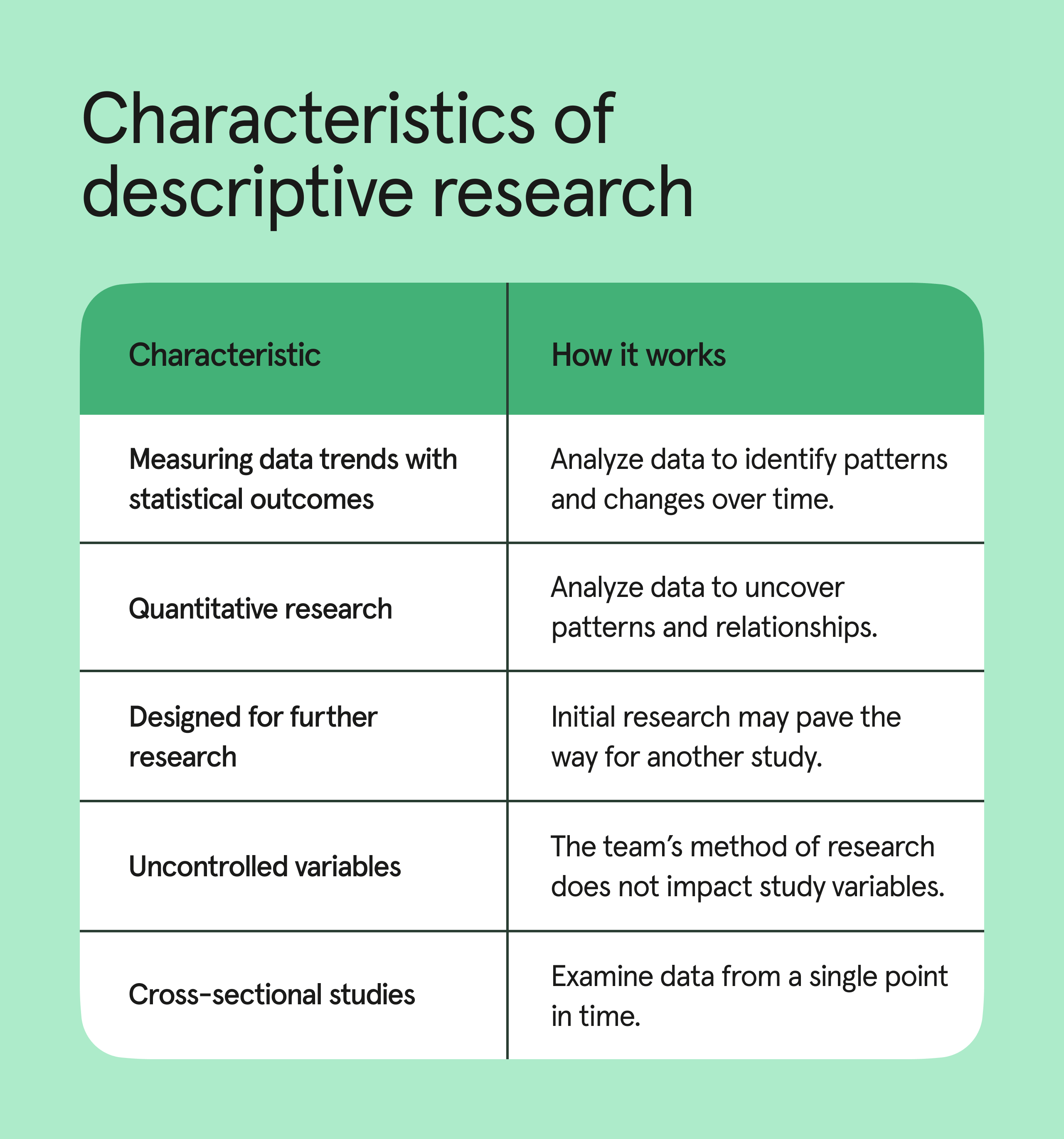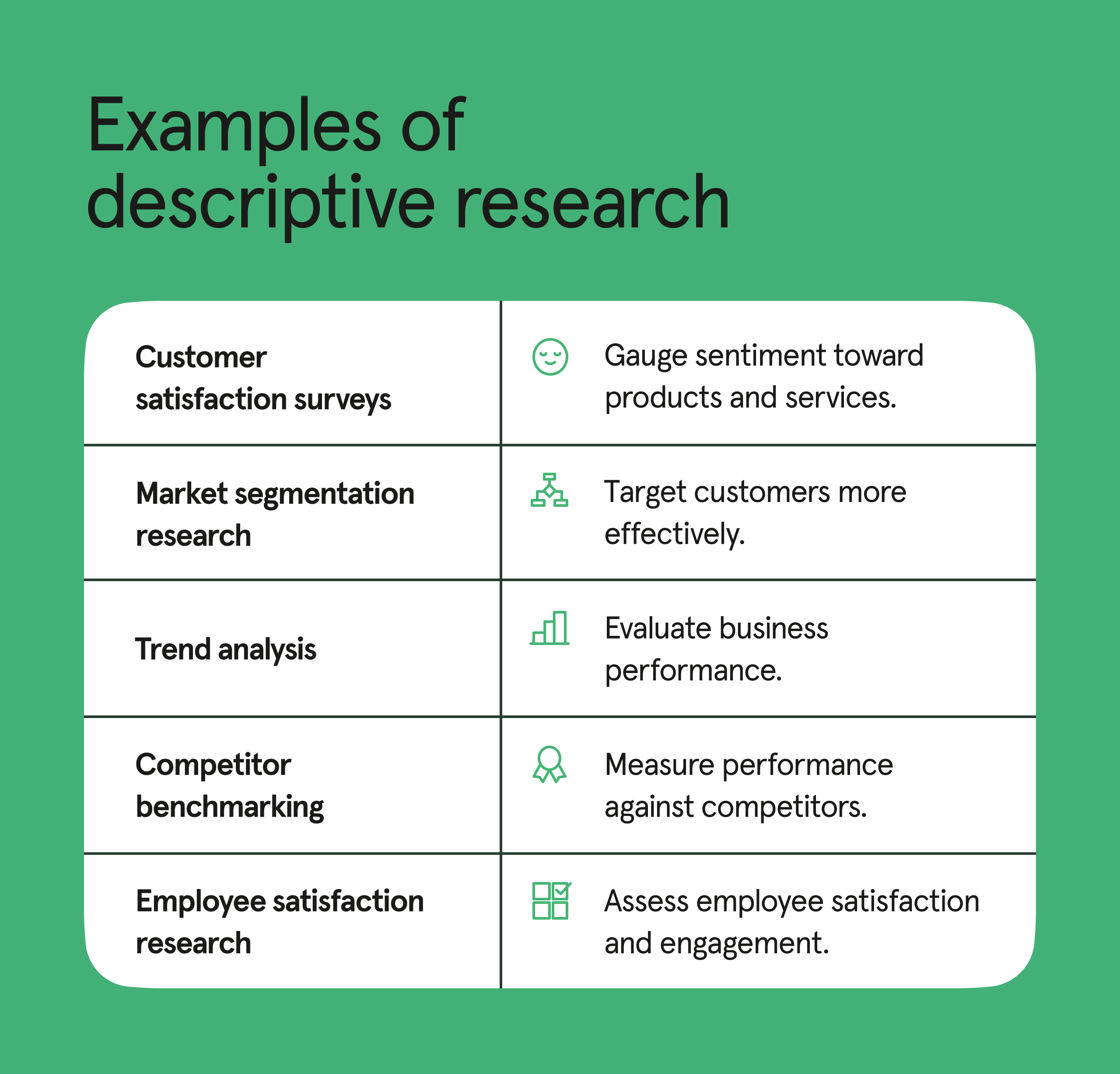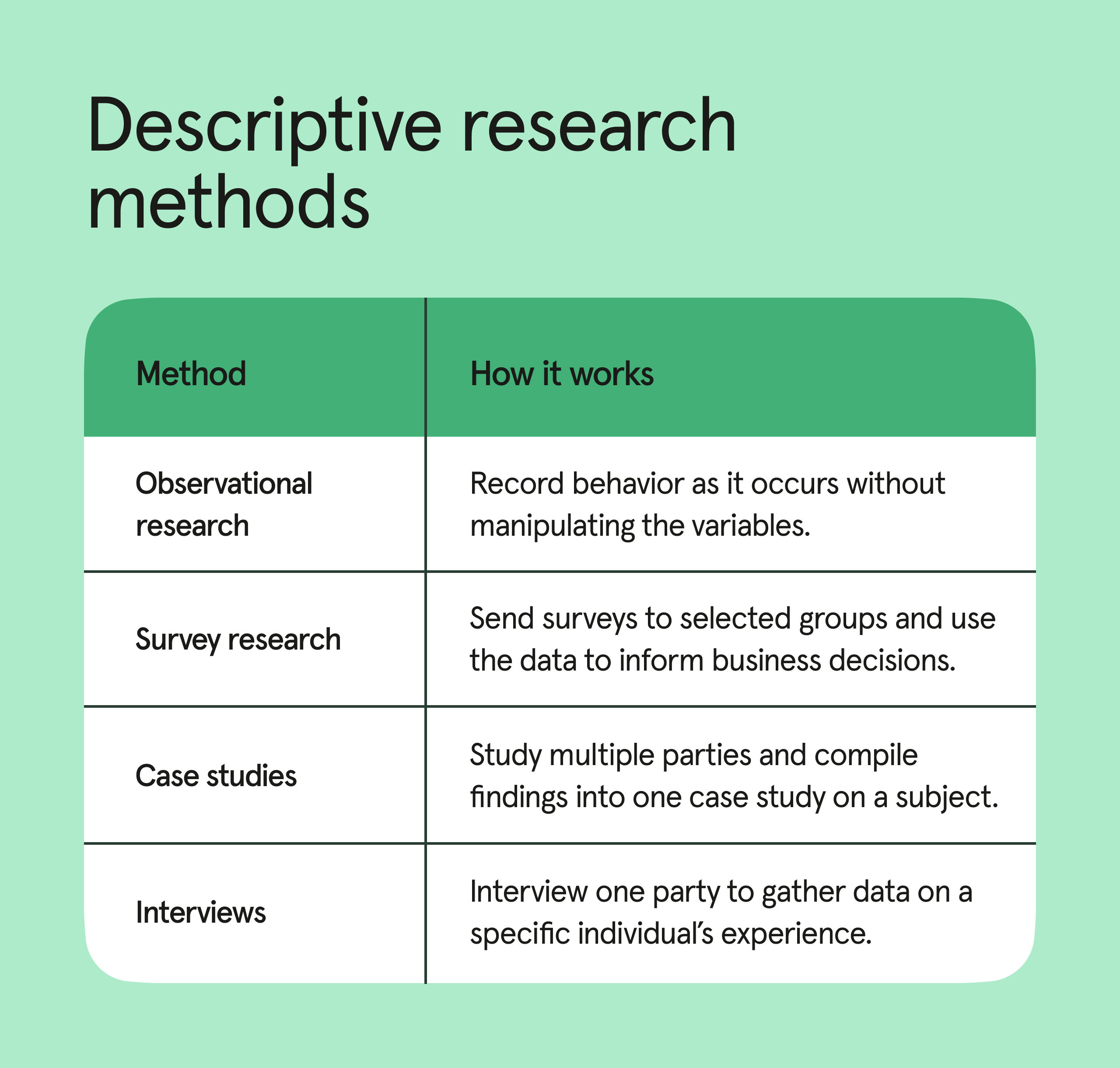Tips
What is descriptive research? Definition, examples, and use cases
Descriptive research is a research methodology that focuses on understanding the particular characteristics of a group, phenomenon, or experience.

Descriptive research is critical in nearly every business—from e-commerce to SaaS to everything in between. Whether you’re selling luxury quilted comforters or an advanced market research automation tool, you need to know who your customers are, what their preferences are, and how to analyze the competitive landscape.
While you can scrape some of this information from third-party data, there’s nothing like zero-party data for the most accurate information about your customers. (After all, why not go straight to the source?) That’s why research methods like surveys, observational studies, case studies, and other descriptive types of research are necessary: They all provide that sweet, sweet zero-party data for your team.
Today, we’ll explore the nature of descriptive research and what differentiates it from other research types—plus look at how you can put these strategies to work for your business.
What is descriptive research?
If you want to understand your customers better, descriptive research is a powerful tool for determining what users want. This approach is typically used to discover more information about a specific segment or demographic or to further segment an existing group.
It can be helpful to think of descriptive research as the opposite of experimental research—if you’re doing experiments, you’re changing variables in your target group. (Think of famous experiments like Newton’s discovery of light!) If you’re doing descriptive research, however, you want to understand the characteristics of your target group without changing any variables.
In business, the data from research like this is invaluable, as it can help you better understand (and segment) your customers.
Descriptive research characteristics
Now that we’ve learned about the definition of descriptive research, let’s look at some common characteristics of research like this. (Spoiler: It’s a lot of surveys.) Because we’re not looking to answer any “why” questions, this type of research will analyze data without impacting or altering it.
If your research contains the following elements, it’s probably descriptive:
- Measuring data trends with statistical outcomes: This method analyzes data using statistical tools and techniques to identify patterns and changes over time.
- Example: A retail business might analyze sales data from 2013-2023 to identify seasonal trends, then use that data to predict future sales peaks.
- Quantitative research: This method analyzes numerical data to uncover patterns and relationships—frequently utilizing the forms or surveys we know and love.
- Example: A SaaS company might survey users to discover usage rates and patterns per feature to optimize their product better.
- Designed for further research: If your research has different phases and starts with a general study to pave the way for a more detailed study, that’s descriptive research.
- Example: A payroll management software company might conduct a study to gauge customer satisfaction levels, which could then lead to a study further analyzing specific parts of the tool.
- Uncontrolled variables: In descriptive research, none of the variables are impacted by the team doing the research in any way. (Doing so could introduce bias and impact the validity of the research.)
- Example: In a study examining internal employee satisfaction, you might be unable to account for individual health or family concerns.
- Cross-sectional studies: These studies examine data from a single point in time, like taking a picture of your audience at a specific moment.
- Example: An online retailer looks at customer satisfaction in December to optimize customer experience during the holiday season.
What is descriptive research used for?
Now that we better understand what descriptive research looks like, you might recognize this research type in work your business is doing already. If so, congratulations, you’re ahead of the game! If not, you may wonder why one might go through all the trouble of doing this in-depth analysis.
Here are a few ways we’ve seen companies successfully leverage descriptive research:
- Customer satisfaction surveys: A company might conduct a customer satisfaction survey to gauge customers' feelings about their products or services. By asking customers to rate their experience with product quality, customer service, and even pricing, the business can identify strengths and areas for improvement.
- Market segmentation research: A company might use descriptive research to segment its market based on demographic, geographic, and behavioral characteristics. This helps the marketing team target specific groups more effectively.
- Trend analysis: Analyzing historical survey data to identify trends and patterns can help businesses forecast future sales, surface key insights, and even benchmark for future performance.
- Competitor benchmarking: A company might use descriptive research methods to benchmark performance against competitors. (Yes, you can!) A simple customer research survey can arm your team with information on competitors' pricing, product offerings, and market share.
- Employee satisfaction research: A company might conduct research to assess employee satisfaction and engagement. An employee satisfaction survey can help businesses understand their workforce and identify factors contributing to job satisfaction or dissatisfaction.
Descriptive research methods
Now that we’ve covered some examples of descriptive research in the wild, you may be itching to start your own. Here are the four descriptive research methods and how to utilize them.
Observational research
The observational research method is perhaps the simplest (and arguably the most effective) of the descriptive research methods we’ll examine today. In observational research, the researcher simply records behavior as it occurs without manipulating the variables. This can look like qualitative or quantitative research—and yes, both can be observational!
In qualitative observation, the researcher simply documents what they see and hear. They may not even need to interact directly with the study subjects. This can include social media research, focus group interviews, forum discussion analysis, or even surveys with open-ended questions.
In quantitative observation, the researcher takes a much more structured approach to collecting hard data. For example, they may perform detailed data analysis on survey results containing information about age, race, gender, position, or industry. They can then splice and dice the results to reveal numerical insights about the group in question.
When utilizing either of these methods, you’ll want to be careful not to skew the data as you work. (For example, don' t accidentally exclude any customer segments!)
Survey research
Survey research is fairly simple conceptually—it does what it says on the tin. (They’re probably also the first thing you think of when you think of market research.) A researcher using this method sends surveys or questionnaires to the selected groups and uses the data gleaned from this research to inform business decisions. Surveys are a very popular research method due to their accessibility and straightforward nature, as users can access them online and from any location.
Case studies
Case studies are another popular method of performing descriptive research. They’re a great way to dive deep into the experiences of a particular individual or group and really understand that specific experience with your product or service. You can do this using multiple interviews with multiple parties involved.
The downside is that data gleaned from these studies may not be particularly quantitative—but you will likely get a very strong understanding of how your customers feel about the topic of your study.
Interviews
Finally, a method of descriptive research design that’s gaining popularity in businesses is the interview method. This is distinct from the case study method in that interviews focus on gathering in-depth information from individuals, while case studies comprehensively analyze a particular experience within a context. All case studies should contain interviews—but not all interviews must be part of case studies. It’s sort of a squares-and-rectangles situation.
Descriptive research pros and cons
All that said, there’s no one-size-fits-all solution for learning about your customer in a practical, actionable way you can accomplish in a reasonable amount of time. Next, we’ll cover the pros and cons of this type of research—and how we see research teams working with (and around) those elements.
Pros
- Detailed data collection: Descriptive research provides rich and highly detailed data about the studied demographics. You can analyze this data and use it for various market research purposes.
- Cost efficiency: With the power of online surveys, research is easy and cost-efficient.
- Highly accurate: Descriptive research captures a highly accurate picture of the subjects, meaning any data you glean will be valuable to your business.
- Versatile: This method can be applied across various fields and disciplines and used for business research of almost any variety.
- Easy to build on: Once you’ve begun a descriptive research program, it’s easy to build on year after year—making each compounding round of research more valuable.
Cons
- Time-consuming analysis: While collecting large swathes of data may be easy—especially with surveys—analyzing that data can take time and resources.
- No causality data: Since you’re only looking at a snapshot of data, you won’t know why certain things are true, only that they are true. Additional research may be necessary to discover more.
- Static: Again, since you’re only getting a snapshot of data, it will not remain accurate over time, and you may need to do another study to keep your information up-to-date.
Examples
Here are some examples of descriptive research in practice.
Example 1: Customer satisfaction in the hospitality industry
A cruise line conducts a comprehensive survey of guests who have booked travel with them in the last year. The survey includes questions about their stay, including ease of booking, room cleanliness, staff service, check-in and check-out, food and beverage experiences, entertainment options, and overall satisfaction.
The company can then analyze this data to identify patterns, such as the most common complaints about food options. The data is then shared with hospitality management to improve the quality of the food on the cruise.
Example 2: Market segmentation for a SaaS platform
A company that developed a SaaS platform for developers conducts a cross-sectional market research study to understand its users' demographics and usage patterns. They collect data on users’ location, industry, number of employees at the company, frequency of use, and more.
By analyzing this data, the company identifies distinct market segments, such as learning that a large percentage of its users serve the automotive industry. This allows the company to develop new features explicitly targeted to these users.
Example 3: Employee engagement at a dental office
A dental practice conducts an annual employee engagement survey to measure employee satisfaction at the company. The survey covers topics such as work-life balance, management support, career development opportunities, and company culture.
The survey results show a trend toward employee dissatisfaction with the policies for requesting paid time off, allowing leadership to revisit those policies. By positively addressing these policies, the following year’s employee satisfaction rate increased by 25%.
Ready to get started?
Research doesn’t have to be hard. If you’re ready to learn more about your customers, users, or employees, don’t overengineer it. Typeform’s user-friendly form templates make research easier for you (and more fun for everyone else!). Try Typeform for free today.





.png)

